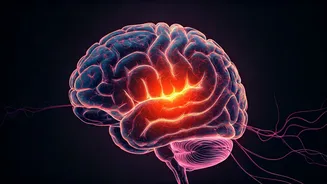Phantom Limb Pain
One of the most perplexing conditions involves the experience of pain in a limb that is no longer present, known as phantom limb pain. After an amputation,
a person might feel intense pain, burning, or itching in the missing limb. The reasons behind this phenomenon are complex. Scientists believe that it arises from a combination of factors, including the remapping of the brain's sensory cortex, which continues to receive signals from the missing limb. Neurons in the brain's sensory cortex, which once represented the amputated limb, now might become activated by signals from other areas of the body, leading to the sensation of pain. This illustrates the brain's plasticity and its capacity to create new neural pathways. Treatments can range from mirror therapy, in which patients use a mirror to create the illusion of the missing limb, to medications, nerve blocks, and even virtual reality, all aimed at retraining the brain and alleviating the pain.
Conversion Disorder Unveiled
Conversion disorder presents a different picture, where psychological distress manifests as physical symptoms that defy any identifiable physical cause. Individuals with this condition might experience paralysis, blindness, or other neurological symptoms, yet medical evaluations reveal no underlying physical reason. It's thought that the person's psychological conflict or trauma is, in essence, 'converted' into physical symptoms. A person might feel as if they're experiencing seizures, but when studied with EEGs, there is no electrical activity in the brain to support that conclusion. Diagnosis often involves ruling out other medical conditions and recognizing the psychological factors that may be contributing to the symptoms. Treatment often includes psychotherapy to address the underlying psychological issues, which helps the person understand and manage their symptoms. Conversion disorder highlights the powerful influence the mind can have on the body, demonstrating that psychological stressors can, in extreme cases, lead to physical manifestations.
Stress and Ulcers
The link between stress and physical health has been widely researched, and its effects on the digestive system are well-documented. Studies reveal that chronic stress increases the risk of developing peptic ulcers. Although the primary cause of ulcers is typically the bacterium Helicobacter pylori, stress can weaken the stomach lining and make it more susceptible to this infection, and even exacerbate the symptoms. Stress disrupts the body's natural balance, decreasing the production of protective mucus in the stomach and increasing the production of stomach acid. Therefore, stress weakens the natural defenses, thus, leaving the stomach lining vulnerable to damage. Management techniques often involve lifestyle changes, such as stress reduction techniques like meditation or yoga, along with dietary modifications and medication, especially if the H. pylori bacterium is present. It serves as a stark reminder that prolonged periods of stress can have real consequences for physical health, impacting even the digestive system.
Psychogenic Non-Epileptic Seizures
Similar to conversion disorder, psychogenic non-epileptic seizures (PNES) involve seizure-like activity that is not caused by epilepsy. These episodes can mimic epileptic seizures, with symptoms such as convulsions, loss of consciousness, and other neurological effects. In the case of PNES, however, EEG tests do not show the electrical patterns associated with epileptic seizures. These seizures are often linked to psychological distress, trauma, or other mental health conditions. While they are not caused by the same neurological processes as epileptic seizures, the physical manifestations and experiences can be very real and frightening. Diagnosis usually involves a detailed medical history and EEG monitoring to distinguish between epileptic and non-epileptic seizures. Treatment often focuses on psychotherapy and addressing the underlying psychological issues that may be triggering the episodes. This condition again underscores the complex relationship between the mind and body and the significant ways mental health can impact physical well-being.
Placebo Effect Power
Perhaps the most fascinating of the five is the placebo effect, where a person experiences real physical or mental improvements from a treatment that has no active therapeutic ingredient. This happens because of a person’s belief in the treatment's effectiveness, which can trigger the release of endorphins or other neurochemicals, thus, influencing the body's healing mechanisms. The placebo effect isn't just about believing you're getting better; it reflects a tangible interaction between the mind and body. Studies have shown that the placebo effect can reduce pain, improve immune function, and even affect physical symptoms in certain conditions. The efficacy of placebos highlights the immense power of our expectations and the brain's ability to influence the healing process. Understanding the placebo effect is crucial, as it provides insights into the brain's role in the body's healing processes and the importance of a patient's belief in the efficacy of treatment. It serves as a reminder of the complex and profound relationship between our minds, bodies, and our overall health.















